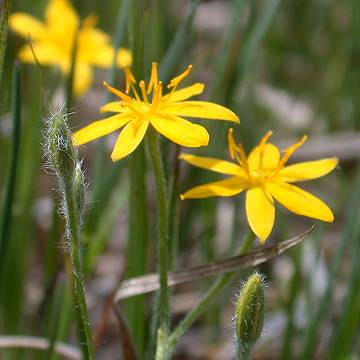

Hypoxis hirsuta - (image 1 of 6)
Taxonomy
Family: Amaryllidaceae
Habitat
Prairies and moist calcareous meadows. Sometimes found in woods that are kept open by fire. I once found it growing on an open slope adjacent to a bog.
Associates
In prairies with Comandra umbellata, Dodecatheon meadia, Eryngium yuccifolium, Gentiana puberulenta, Heuchera richardsonii, Krigia biflora, Lithospermum canescens, Lobelia spicata, Pedicularis canadensis, Phlox pilosa, Senecio plattensis, Silphium laciniatum, Sisyrinchium albidum, Sporobolis heterolepsis, Viola affinis, Zizia aurea.
Distribution
From the Rockies east.
Morphology
Herbaceous monocot. Stems cylindrical and tapering (terete). Leaves basal, grass-like, hairy. Petals and sepals 3, yellow, similar; stamens 6; ovary inferior; in umbelloid cymes of up to 3 flowers.
Notes
Flowers mid June to early October
Wetland indicator: Facultative wetland-
The leaves are almost indistinguishable from the surrounding grasses, impossible to find when it is not in bloom. The dainty little flowers add to the color of the prairies in spring.
A bit of a side note since I found some sources putting this in the Lily family. Plants in the Liliaceae are distinguished from similar families in having the ovary superior and a black seed coat. Plants in the Amaryllidaceae have the ovary inferior, a black or blue seed coat, and flowers in umbelloid cymes.
Bibliography
Niering, W. A. 1979. The Audubon society field guide to North American
wildflowers: eastern region.
Knopf/Random House, New York.
Peterson, R. T. and M. McKenney. 1996. A Field Guide to Wildflowers:
Northeastern and North-Central North America.
Houghton Mifflin Company. Boston, MA
Swink, F. and G. Wilhelm. 1994. Plants of the Chicago Region.
Indiana Academy of Science. The Morton Arboretum. Lisle, Illinois.
|
Michael Hough © 2005 |